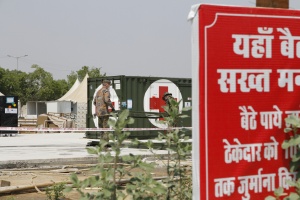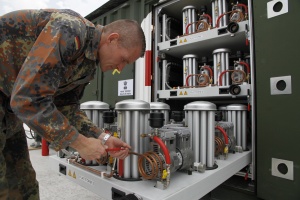
Article: Claas Gärtner
Coronavirus pandemic: Oxygen for India
In early May, almost 45 °C prevail on the almost 15x25 m light grey concrete slab on the premises of the Sadar Vallabhbhai Patel Covid Hospital in New Delhi, an improvised military hospital consisting of tents. In a green 20-feet container with Red Cross emblem and air vent screens high-pressure compressors are softly humming while only a few metres away, corona deaths are transported to ritual cremation at minute intervals. In the adjacent tent, directly beside the container, Indian technicians are screwing adapters onto large oxygen bottles. In between, soldiers of the Bundeswehr Medical Service who familiarise the Indian engineers with the particularities of the mobile oxygen production and filling system.
 The mobile oxygen production and filling system can be employed independently, but also in combination with other medical facilities.
Photo: Fritz Stephan GmbH
The mobile oxygen production and filling system can be employed independently, but also in combination with other medical facilities.
Photo: Fritz Stephan GmbH
Only ten days earlier, a team of the Bundeswehr Joint Medical Service had travelled to New Delhi upon request of the Indian government to support the country with oxygen production capacities. In early May, India had to mourn several thousands of corona deaths each day, and the health care system was overburdened. Especially in the coronavirus hotspots, the life-saving gas was lacking. Here, the assistance from Germany was to set in, and a team of 13 servicemen and women of the Bundeswehr Joint Medical Service was tasked with providing India with oxygen. The team was headed by Colonel Jürgen Thym from the Bundeswehr Medical Service Headquarters. When the operationally experienced senior officer received the mission, he immediately knew: "We go there together and will accomplish our mission. To help people in need and under dangerous and adverse conditions is the core of our self-image as military medical service."
Within only five days after arrival at Indira Gandhi International Airport, he and his small team had not only explored and prepared the installation site, and put into service the mobile oxygen production and filling system, but also familiarised the Indian technicians with the system in three days. The goal was clear: save lives by producing about 400,000 litres of high-quality medical oxygen per day.
From wish to reality
The first concrete steps towards the procurement of a mobile oxygen production system were made already in 2009. The first ideas for such a system and the possibility of integrating such a system into medical facilities had developed already three years before. Since, especially with a large number of severely wounded soldiers, the success of treatment depends significantly on the availability of medical oxygen, the Bundeswehr wanted to have its own capability to produce oxygen.
Before this project could be implemented, a monograph "Oxygen from concentrators / oxygen 93%" had to be prepared for the European Pharmacopoeia (Ph. Eur.), since the process of filling and refilling molecular sieve oxygen is a pharmaceutical production process and oxygen 93% is a medicinal product that must meet regulatory requirements. In 2007 already, Bundeswehr Medical Office, Division VIII Military Pharmacy, had prepared and harmonised with the Federal Institute for Drugs and Medical Devices the draft of a monograph in such a way that it could be accepted for hearing and discussion in a meeting of the European Pharmacopoeia Commission (Ph. Eur. Com.). In cooperation with the French Army, information on their trials on molecular sieve oxygen production were included in this draft. Finally, the monograph No. 2455, Oxygenium 93 per centum (O2 93) was published in the European Pharmacopoeia in 2010. Thus, the preconditions had been created for the lawful production and application of oxygen 93% as medicinal product in the Bundeswehr.
The military procurement process had to consider the general principles of initial and resupply as well as a comprehensive and resilient, that is consistent, supply strategy for medical oxygen. A mobile system for the production and filling of oxygen that could be integrated into the existing system of modular medical treatment facilities (MMTF) of the Bundeswehr was ideal for this purpose, because Role 1 – 3 medical treatment facilities (MTF) in the theatre of operations as well as tactical and strategic medical evacuation (MEDEVAC) are the main users of medical oxygen.
The first of six mobile oxygen production and filling systems to date was handed over to the Bundeswehr in 2011. The first field test with its core components was performed during the then ISAF mission in the camp of the Provincial Reconstruction Team Kunduz.
The system, which consists of a 20-feet function container (oxygen production, storage and transport container), one Type II standard tent with two locks, a loading platform, two 70kVA power generators and a wide range of accessories, as for instance the ZKB15 tent air-conditioning unit, will generally be set up in the theatre medical logistics point or, if required, in the Medical Service logistic support point and will be supplied to the medical treatment facilities according to the supply principle. Each mobile oxygen production and filling system can produce up to 400,000 litres of oxygen per day and fill it into 2- to 50-litre compressed-gas cylinders with a pressure of 200 bar. In addition, three of the six systems are intended to feed oxygen directly into the oxygen piping systems for instance in field hospitals and mobile surgical hospitals at low pressure. In this case, the system, as far as the supply with POL is concerned, must be integrated into the logistic processes of the respectiv medical treatment facility. The equipment of the direct-feeding variant includes the so-called reserve container, since the oxygen supply systems to feed oxygen into medical piping systems in accordance with DIN EN ISO 10083 must have a bottle-based reserve supply source consisting of two separate bottle lines.
Oxygen production in detail
As an autonomous system, the mobile oxygen production and filling system can be set up and operated at almost any location in the world. The system uses the so-called molecular sieve technology to enrich oxygen from the ambient air up to 96%. The heart of the system, the function container, consists of three areas: a technical room with air-conditioning and -monitoring unit, the main component with the oxygen enrichment unit and the two high-pressure compressors, and finally the filling station for pressure-gas cylinders.
The enrichment of oxygen from the ambient air takes place via molecular sieves that are distributed over several platforms. First, the ambient air is sucked via the platforms and pre-compressed to 1.5 – 1.7 bar. The air is then ducted through the so-called ATF module with the molecular sieves. They contain zeolites (crystalline aluminosilicates) that have a high degree of adsorbability for gases with certain molecule sizes. The zeolites used preferably adsorb nitrogen, which enables enrichment of oxygen from the ambient air. At optimum performance, a maximum oxygen concentration of 96% can be achieved since also argon, a nontoxic noble gas, is also enriched from the ambient air. In the process, the molecular sieves are quickly saturated with nitrogen and require regular regeneration. In order to enable continuous oxygen separation, several molecular sieves are always operating in parallel in the mobile oxygen production and filling system.
After separation, the oxygen is stored at 6.5 bar in two storage tanks in the container with a volume of 365 litres. From these tanks, the oxygen then enters the high-pressure compressors, which compress the gas to 200 bar for filling after further filtering. Filling and production may take place simultaneously.
 Last check of the platforms with the AFT modules in India before putting the system into operation.
Photo: Claas Gärtner / PIC Bundeswehr Medical Service
Last check of the platforms with the AFT modules in India before putting the system into operation.
Photo: Claas Gärtner / PIC Bundeswehr Medical Service
Complex tasks for the personnel
The 20-feet function container, oxygen production, of the mobile oxygen production and filling system contains cutting-edge technology that must be safely mastered by the servicemen and women even under adverse conditions. Knowledge of the technology is indispensable for a safe operation of the system, and at the same time, the pharmaceutical and legal framework must be observed. The Bundeswehr relies on a personnel combination of pharmacists, pharmaceutical-technical assistants and technical staff for operating the system.
Task of the pharmacists and pharmaceutical-technical assistants is to fill the oxygen into cylinders and sample the oxygen produced. Medical oxygen 93% is a medicinal product and in accordance with a monograph of the European Pharmacopoeia is produced in bulk to keep in stock and tested by pharmaceutical personnel (pharmaceutical-technical assistants and pharmacists) (Monograph PhEur 8.0/2455: Oxygenium 93 per centum). Each batch is also tested for identity, purity and content. Only if the results of the tests are in line with the guidelines, a pharmacist will release the medicinal product. Pharmaceutical personnel are trained within the scope of the training "Production of medicinal products in mission".
The technical staff (electricians, fitters) are responsible for the operation, maintenance and care of the system. Since the mobile oxygen production and filling system is no medicinal product but a technical installation, medical technologists are not required for its operation. The technical staff can carry out repair and scheduled maintenance action up to maintenance level 3. This includes for instance the exchange and servicing of components like the ATF modules, but also the repair of small compressor units. These activities require training that is carried out in modules over several months.
In addition, when transporting and deploying the system, close cooperation for instance with the dangerous goods safety adviser of the unit is of particular importance.
Experience
Beside their employment in India, the oxygen production system of the Bundeswehr Medical Service has also been employed in Germany during the coronavirus pandemic. The Bundeswehr Medical Service deployed one system to 3 Medical Regiment in Dornstadt to be able to support the Bundeswehr Hospital Ulm in the event of a disruption of the civilian oxygen supply chains that was conceivable at that time. For the same purpose, a second mobile oxygen production and filling system was installed at 2 Medical Regiment in Koblenz. Further systems are held in the Medical Logistics Centres of the Bundeswehr in Quakenbrück and Blankenburg.
Whether in Germany or India, the mobile oxygen production and filling system proved its operational effectiveness during the coronavirus pandemic - even outside a national/collective defence scenario. After 18 days in India, Colonel Thym drew the same balance: "We have accomplished our mission, we have saved lives."
Author:
Kommando Sanitätsdienst der Bundeswehr
Lieutenant Colonel Claas Gärtner
Falckenstein-Kaserne
Von-Kuhl-Straße 50
56070 Koblenz
Date: 07/26/2022
Source: EMMS 2022











